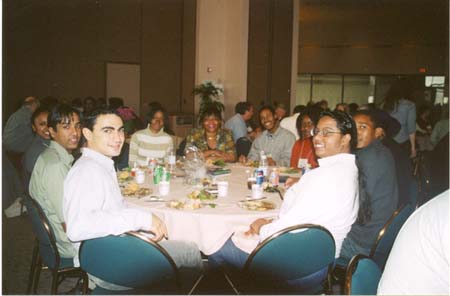Winter 2003  Page 2
Page 2
"Undergraduate
Mentoring in Environmental Biology" Grant Helps Faculty Members Reach
Students
Kathleen A. Nolan,
St. Francis College, Brooklyn; and Carolle Nicolas-Bolnet, Medgar Evers
College, Brooklyn; and Rob DeSalle, American Museum of Natural History
This was the perfect grant for us! The title of the National Science Foundation Request for Proposals was “Undergraduate Mentoring in Environmental Biology”. Kathy showed Rob the RFP and he said, “Let’s go for it---call Carolle at Medgar Evers and get her on board. We’ll have a three-way Brooklyn-Manhattan urban environmental collaboration!”
That was the easy part. Then came writing a federal government grant proposal—Kathy’s first. (For this RFP, one needed to collaborate with a PI who currently held an NSF grant—Rob). We spent the next two weeks from 9 A. M. to 7 P.M. putting the proposal together. The deadline was January 31, 2000---during the semester break, which wasn’t too bad.
Our proposal was rejected. Not enough information about mentoring. Back to the drawing board, except that the deadline had been changed to October 31, 2000, smack in the middle of the semester. This time there were 11 P.M. evenings, after teaching classes all day.
Rejected again! Next, came the trips to Washington, D.C. to try to figure out what we were doing wrong. Aha! Uncle Sam wanted St. Francs and Medgar Evers to take more of a piece of the action and administer the grant through their own institutions as well as through the Museum. The program officer felt that the smaller colleges were being dwarfed by the Museum and were not stepping up to the plate.
We got the gist of it, finally, and got the grant (effective September 1, 2002)--all $400,000 of it, to be used over a four-year period.
This project will fund twelve students (from under represented groups in science--six at each campus) to conduct projects in environmental biology over a two-year period for each student. The students may work up to fifteen hours a week during the academic year, and two weeks full time during the breaks and the summer. During the school year they will do most of their research at the home campus, and the summers will be devoted to conservation genetics projects at the Museum or abroad. There is also money for supplies, travel, and summer salary for the two college PIs. The whole idea behind the program is to immerse the students in environmental biology and to get them to think about careers in this area. The program, in addition to individual research projects, includes workshops, research and career seminars, luncheons, and field trips. For example, the students are required to attend the annual Metropolitan (New York) Association of College and University Biologists annual fall conference, and present posters.
Our program is already evolving. We initially had a very specialized focus of conservation genetics complete with much DNA sequencing, to which we are still very committed. But we realized that our undergraduate students sometimes only have bits of time between classes, and need to do projects on our campuses during the academic year. The students will spend some time during the academic year at the Museum, which is an hour away by subway. Rob is going to transfer some technology from the Museum to our campuses, i.e. a DNA sequencer and some PCR machines.
Both Kathy and Carolle started with three students each this semester, but two have left to go to other colleges. So we are recruiting more students, and will even add a few more, because our students have been finding it difficult to keep up with their schoolwork and the fifteen hours of the UMEB program a week. They are probably only able to work ten hours a week at the most, so we will be able to give a few hours to a few other interested students.
Carolle has been isolating colonies of bacteria from water collected from two points in Jamaica Bay, New York City. Jamaica Bay is being explored as a place to reintroduce the oyster, Crassostrea virginica. She and her students will isolate DNA from the colonies and sequence it later this semester and over the summer.
Kathy’s students have been focusing on isolating DNA from two closely related species of herring---blue backs and alewives---and Daphnia. Her students are currently in Trinidad over the semester break studying the shrimp industry. They are sorting out organisms from various shrimp tows for an ecological distribution study. They are also preserving organisms in seventy-percent alcohol, so that we might sequence the DNA in the future.
An additional two students will be recruited to conduct pond water analysis studies, and to work with laptops with the Vernier probe system to test water for dissolved oxygen, pH, conductivity, and gas pressure. These probes directly interface with the computer and graph the data in real time. (Do we see a major ABLE workshop on this in the future?)
The students from both campuses will be shadowing graduate students in the Molecular Systematics lab at the Museum for a few hours each week this semester. We also have three Saturday molecular biology and systematics technique workshops planned.
The mentoring process has been interesting. We have been helping students (a) learn how to call in when they aren’t able make it and (b) learn time management---i.e. it is more profitable for you to put in four hours on your research for $40 than to travel on the subway an hour each way to tutor someone for $15 an hour for two hours!
We will give you periodic updates as to how we are progressing!!

Students involved in the project
![]()
© 2003 ABLE. All rights reserved.